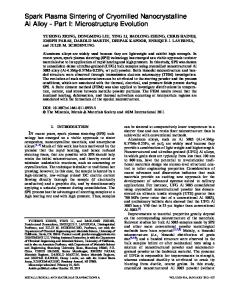Transparent nanocrystalline MgO by rapid and low-temperature spark plasma sintering
- PDF / 1,125,438 Bytes
- 5 Pages / 612 x 792 pts (letter) Page_size
- 50 Downloads / 264 Views
Zhijian Shen and Mats Nygren Department of Inorganic Chemistry, BRIIE Center for Inorganic Interfacial Engineering, Arrhenius Laboratory, Stockholm University, S-106 91 Stockholm, Sweden (Received 29 January 2004; accepted 29 March 2004)
We investigated superfast densification of nanocrystalline MgO powders by spark plasma sintering (SPS) between 700 °C and 825 °C under applied pressures of 100 and 150 MPa. Fully-dense transparent nanocrystalline MgO with a 52-nm average grain size was fabricated at 800 °C and 150 MPa for 5 min. In-line transmissions of 40% and 60% were measured compared to MgO single crystal, for the yellow and red wavelengths, respectively. Densification occurs by particles sliding over each other; the nanometric grain size and pores lead to the optical transparency. The light brownish color of the nanocrystalline MgO is due to the oxygen vacancy color centers, originating from the reducing atmosphere of the SPS process.
Most sintered polycrystalline ceramics are transluscent or opaque to light. This character stems from the porosity and grain boundaries, in the length scale of the optical wavelength. This situation has extremely limited the application of ceramics for optical and photonic applications. Optical transparency requires extended vacuum sintering at very high temperatures (0.6 to 0.8Tm), depending on the applied pressure.1,2 Densification at these conditions occurs by lattice and grain-boundary diffusions with very slow kinetics. It is worth noting that surface diffusion with much faster kinetics (at 0.3Tm) is responsible for coarsening of the particles, but such diffusion is not responsible for their densification. However, correct application of this mechanism under applied pressure may result in fully dense transparent ceramics at short durations and relatively low temperatures. For this purpose, nanocrystalline (nc) ceramic powders are required, due to their high specific surface area. These highly active surfaces lower the sintering temperature during pressureless sintering of green ceramic compacts.3,4 Fundamental defects (such as pores) may still remain stable in the compact if the pore size is much larger than the particle size.5,6 This method requires the preparation of very homogeneous green compacts, within which the pore size is of the same order of the nanocrystalline particle size (an impossible task via the dry powder technology). Consequently, pressureless sintering of nanocrystalline ceramics at relatively low a)
Address all correspondence to this author. e-mail: [email protected] DOI: 10.1557/JMR.2004.0334 J. Mater. Res., Vol. 19, No. 9, Sep 2004
temperatures,7,8 and even for prolonged sintering durations,9 is accompanied by residual porosity. In addition, the slow heating rates (of the order of 2 to 5 °C/min) applied in conventional sintering provides enough time for particle coarsening, up to the sintering temperature. This situation, in part, results in the loss of the powders’ driving force for sintering, hence in partial densification. Recently, translusce
Data Loading...











